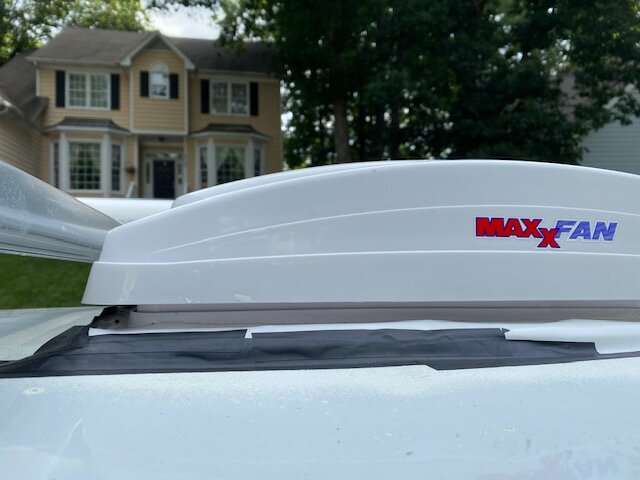waterproofing and sound deadening
The first big consideration is sound deadening.
“Kilmat is used in cars for sound systems, but you have to use it in a van because if you don’t, when it rains, it’s basically like sleeping in a tin shed,” Doug explained to me. “So that was the first thing I did, was cover as much as I could with Kilmat.”
Building out a van yourself gives you the creative freedom to put down Kilmat shaped like Pyramid Head
An added bonus to the solar panels is that they cover most of the roof and absorb the rain noise.
The other big consideration is preventing leaks.
These Van Upgrades air vent inserts let you crack the window without letting in rain (or bugs)
This clamshell vent cover prevents water from running into the exhaust fan for our composting toilet (you really, really don’t want that fan to stop working)
The MaxxFan has a built-in rain shield; their main competition, Fan-Tastic, requires you to buy the shield separately. (I hate to malign them because their website is really cute, but MaxxFan is the industry leader for a reason.)
And then there’s Flex Seal.
I’m pretty sure I’m the last person in the world to hear about this stuff, but just in case you actually live under a rock (and not just in Antarctica like some of us), Flex Seal is basically spray-on rubber sold by the reincarnated ghost of Billy Mays.
Turns out getting yelled at by an avuncular maniac with a chainsaw is effective marketing, so Doug and I bought a bunch of Flex Seal — and its brother, Flex Tape — to waterproof the hole for the MaxxFan.
The MaxxFan is designed for the flat roof of an RV, but the roof of our Transit is concave. Doug used some slivers of leftover vinyl flooring to bridge the gap, and then covered the whole mess with Flex Seal. It held up fine when the van was sitting in the driveway in Jersey, but after an intense rainstorm outside of Gatlinburg, Tennessee, we discovered a small leak. Upon closer inspection, the Flex Seal spray had developed a series of small holes and cracks. Doug patched it up with electrical tape until we could cover it with Flex Tape.
Brooke: What are your thoughts on Flex Tape and the Flex Seal family of products?
Doug: Your stepdad said yesterday that the marketing is great. It got us. Flex Tape seems to be okay, but the Flex Seal failed —
Brooke: — but only on one side.
Doug: Yeah, and a lot of that has to do with the concave of the roof. It’s a lot more complicated than sealing a little gap —
Brooke: Ceiling?
Doug stares blankly at Brooke.
Brooke: Get it?
Doug continues to stare blankly at Brooke.
Brooke: Sorry, please go on.
Doug: The Flex Seal deteriorated. Lee was saying if you read the fine print, it says you gotta reapply it every six months.
And now we know. We’d recommend using Flex Tape to seal cracks and just keeping an eye on it.





